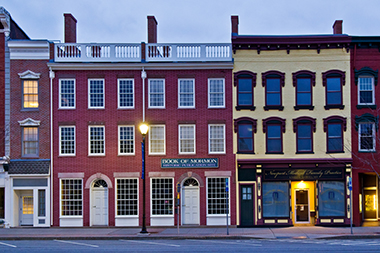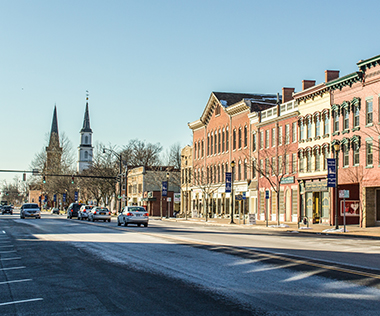Church Honors Palmyra Historian with 1907 Photo of City
Contributed By By Elizabeth Sutton, Cumorah Multistake Public Affairs

Rand Packer, left, and Elder Richard Searle present a 1907 photograph of Palmyra to Bonnie J. Hays, longtime friend of the Church and executive director of Historic Palmyra.
Related Links
PALMYRA, New York
In honor of decades of cooperation and friendship between the Church and city of Palmyra, New York, author and historian Rand H. Packer and Elder Richard Searle, director of the Hill Cumorah Visitors’ Center, presented a 1907 George Edward Anderson photograph of the center block of East Main Street, Palmyra, to Bonnie J. Hays, executive director of Historic Palmyra, on January 17 at the Alling Coverlet Museum in Palmyra. Prominently featured in the photograph is the Grandin Building, the location where the Book of Mormon was first printed.
Brother Packer referred to Mrs. Hays as a “treasure” not only because of her knowledge of the history of Palmyra but also because of her friendship to the Church. As an overseer for Palmyra area museums, Mrs. Hays has reserved a special area that houses numerous items associated with the early days of Palmyra, including artifacts and photographs of the history of the Church in this area. Mrs. Hays has been instrumental in maintaining a welcoming environment for LDS missionaries, members, and the many Latter-day Saint visitors who visit Palmyra.

The E.B. Grandin Building on East Main Street in Palmyra, New York, as it stands today. This building is where the Book of Mormon was first printed. Photo by D. Brent Walton.
Because of Brother Packer’s special historical tie to the area, his presence sparked great interest and attention from the Palmyra Historical Society. Brother Packer’s grandparents Willard and Rebecca Bean were the first members of the Church in Palmyra in the 20th century.
When the Beans arrived in Palmyra, they struggled to find acceptance and understanding. After an almost 25-year mission to the Joseph Smith farm, they had developed close ties to the community and established positive relationships that paved the way for the reestablishment of the Church in its birthplace.

Aside from modern additions such as street lights, paved roads, cars, and churches, East Main Street in Palmyra today looks remarkably similar to how it looked back in 1907. Photo by D. Brent Walton.
Following the presentation to Mrs. Hays, Brother Packer paid tribute to the town of Palmyra. Pointing to the well-known corner of Main Street bordered on each side by a different church, Brother Packer commended Palmyra and its citizens for their demonstrated attitude of tolerance and understanding for religious beliefs. Brother Packer spoke of his mother, named Palmyra, who was born and raised in the town. He retold stories of Willard Bean’s respected boxing abilities and unflinching faith, traits that he used to diffuse hostility and misunderstanding. Brother Packer’s love for Palmyra and his familiarity with its history and people continues his grandparents’ legacy.
